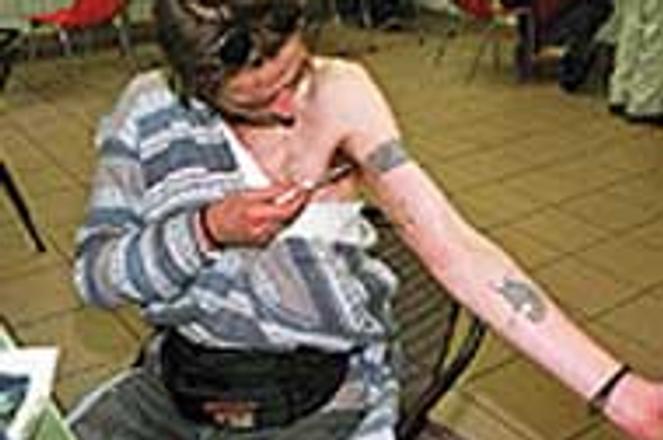A heroin-addict in Germany gets his fix. Slovak statistics show that while drugs are still readily available to the nation's youth, the number of criminal cases invloving drugs have decreased in recent years.photo: TASR
A virtual unknown under communism, drugs became popular in Slovakia after the fall of the Iron Curtain in 1989 when the subsequent opening of the borders introduced former Eastern Bloc countries to marijuana, cocaine, and heroin. In the years immediately after the revolution, drugs became a new fad as explorative Slovaks embraced the west, including its vices.
While the initial wave of drug dependency has decreased in Slovakia over the past few years, the availability of drugs has not. Both Slovak youth and their parents are still learning how to deal with this still new phenomena.
According to the EU School Survey on Alcohol, Tobacco and Drugs (ESPAD), which is carried out every two years in European countries, every fourth teenager in Slovakia has had experience with illegal drugs. Over 60% of respondents said that drugs were easily accessible at discos or bars, 33% said that drugs were easy to purchase on the street, and 28% said that it was easy to get drugs at school.
"Some people go to the movies on weekends. I like to have a joint instead," said 22-year-old Comenius University student Ivan D. of Sučany, a small town near Martin. "It allows me to see things from a different perspective, it helps me to see sharper."
Ivan explained that that he regularly smoked marijuana or had LSD with his friends but that his habit was "under control. I am not an addict and I don't think I should be treated for drug dependency."
But according to Ľubomír Okruhlica, head of the Bratislava-based Centre for Treatment of Drug Dependencies (CLDZ), drug habits are hard to control. "Those who take drugs don't realise how far they've gone with the habit. Usually the environment notices the change first."
Okruhlica added that although marijuana is categorised as a 'soft drug', it is still potentially addictive. "Marijuana is a drug just like any other drug, and I have encountered many people who were heavily dependent on it," he said, explaining that the addiction was mainly psychological.
Robert Kadlečík spokesman for the Ministerial Committee for Drug Dependencies, said that 2,236 drug addicts were treated at all of Slovakia's 12 drug treatment centres last year alone. "Almost 80% were dependent on opiates like heroin, 190 people were treated for dependency to 'evaporates' [such as paint or glue which is sniffed] and 142 were marijuana and hashish addicts," he said.
Kadlečík said that Slovakia had experienced its biggest drug boom from 1992-1993. "These were the years of the 'heroine epidemics', especially in Bratislava," he said. "Heroin still remains the number one drug in the capital [in terms of drug-dependency cases], followed by marijuana and synthetic drugs like ecstasy."
To combat drug-use, Kadlečík said that his committee was working with all Slovak ministries in order to deal with the problem of drug abuse at all levels. Anti-drug projects range from educational programmes for the young to health care for addicts to co-ordinating the police' war against organised drug dealers. "Every year we get 50 million Slovak crowns ($1.19 million) from the state budget to support these projects," Kadlečík said. "We stress the prevention of the problem by teaching our youth about the risks of drug use. Extensive education programmes started three years ago at elementary and secondary schools throughout Slovakia."
But sociologists said that educating the youth was not enough, and that parents, many of whom are more ignorant of drug use than their children, should pay closer attention to the problem. "Many parents who have drug-addicted children pretend that the problem does not exist," said Viktória Joklová, a sociologist who works at a Bratislava telephone help-line. "They don't know how to deal with it, or they just don't want to admit that it's happened to their child."
"Not only do parents treat drug addict children as if they are shameful to the family, parents tend to blame the problem on 'bad friends' who influenced their child," Joklová continued. "Instead of talking to the child at the outset of the problem, they often get angry with him, or just ignore the problem altogether."
The CLDZ's Okruhlica noted that in Slovak society preventing drug-use was further complicated by parent's tolerance of other legal drugs. "Often the people who are the most radical opponents of drugs happen to be dependent on alcohol or cigarettes," he said.
Both Okruhlica and Joklová agreed that curiosity and boredom was the most common motivation for drug-use, especially among young people.
"I had my first joint when I was 20," said Ivan. "It was a matter of curiosity, I was in my first year at university and I was experiencing the city for the first time. Now I buy LSD from dealers - one tab costs about 400 crowns ($9.50). But I never buy marijuana. That's like a friendship drug in Slovakia and very rarely do you have to buy it. People just have it."
Igor Košťál, head of the country's National Anti-drug Squad of the Police Presidium said that prices for different drugs varied according to quality and accessibility. "A gram of heroin costs about 1,500 crowns [$35], cocaine runs up to 3,000 crowns [$70], and a tab of ecstasy varies between 100 and 200 crowns [$2.40 to $4.80]."


